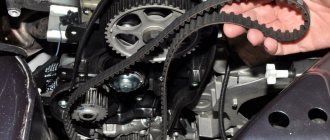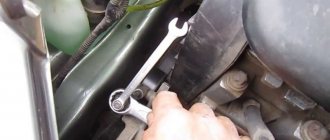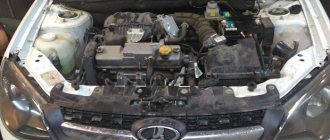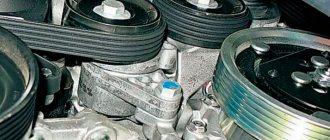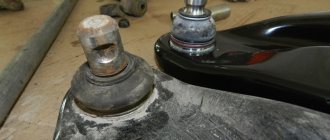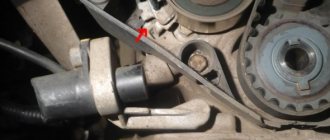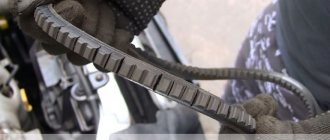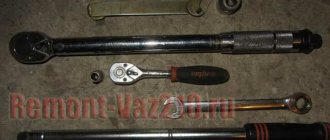How to check the condition of the belt on Largus
A broken timing belt on Largus leads to the fact that the valves remain open, and the pistons hit the “plates”, bending them. Such a breakdown leads to a major overhaul of the cylinder head and replacement of the pistons.
To prevent this from happening, you need to be able to recognize increased wear on the timing belt. Currently there are two ways to assess its serviceability:
- visual inspection;
- extraneous sounds.
An external inspection helps assess the visual condition of the belt. There should be no cracks or protruding burrs on it. It should be smooth and neat. An external assessment of the product can only be carried out with the protective screens removed.
Extraneous sounds can only be discerned by an experienced driver. If there are burrs on the old belt, they will hit the gears and other mechanisms with a characteristic soft sound. This may be a reason to inspect the timing belt.
Which belt should you choose?
When purchasing a belt, it is better to give preference to original components. Finding them on sale is not difficult. And in order to definitely protect yourself from unexpected stops, it is better to also purchase the roller itself as a set. If we talk about analogues, then it is worth choosing products from well-known companies, for example, Bosch or Dayco. As practice shows, they are not inferior in quality to AvtoVAZ products and are also capable of operating for at least 100,000 km without replacement. The timing belt is not one of the problem areas of the Lada Largus, and nevertheless, monitoring its condition is the responsibility of the car owner. As we have already written, the manufacturer recommends replacing it once every 120,000 km, but depending on your driving style and other seemingly insignificant factors, this period may come earlier. To prevent the car from getting stuck on the road and then requiring major engine repairs, it is better to check the condition of the belt every 15 thousand kilometers. This will save you from serious expenses and wasted time.
How to select components for replacing the timing belt on a Lada Largus
The most important thing when selecting this product is the manufacturer. The car owner must be able to distinguish between manufacturers from whom timing belts can be purchased. Below is a list of trusted manufacturers you can trust:
- Renault;
- Lada;
- Gates;
- Contitech;
- Bosch;
- Dayco;
- Lemforder.
Often, original kits may contain belts from manufacturers such as Gates or Contitech. Therefore, there is no point in overpaying. It's better to get a cheaper set.
Another important point when choosing a timing belt is its shelf life. Since this is a rubber product, it has a limited time during which it can be stored.
Special numbers on the belt itself, for example, “5-30”. The number 5 means the year - in this case 2015, and 30 is the number of the week in which the product was manufactured. The permissible storage period of the belt is 5 years. If its age is higher, it is clearly not worth installing such a spare part.
If you install a timing belt on a Lada Largus with an expired expiration date, its breakage may occur even earlier than the required replacement according to the regulations - after 10 or 20 thousand kilometers. By the way, it is after this that bad reviews about the best manufacturers may appear.
To find out the expiration date, just pay attention to the special inscriptions placed on the packaging. For example, “Install < 08.2021”, as in the photo above. This means that this belt can be installed no later than August 2022.
Factory replacement schedule
According to the service book issued by AvtoVAZ, the timing belt should be changed every 50,000 km. In this case, adjustments should be made every 0 km.
But since the Largus is equipped with a Renault engine, these data do not coincide with those written in the Renault service manual.
So, who to believe in this case? It is worth referring to the factory manual, which is published in French for the K4M engine that is installed on Largus.
A similar K4m engine is found in Renault Megane and Renault Logan
According to this document, the timing belt must be changed every 60 thousand km, regardless of condition. The adjustment is carried out, it is worth paying attention - no later than 15,000 km. That is, it can be carried out earlier.
When is it better to change according to the experience of the owners
The valve rockers came off because the timing belt broke.
Having considered the information and experience of many owners of this car, we can say that there are quite a lot of cases when the belt fails ahead of schedule. This is due, first of all, to the quality of the spare part. So, a Bosch timing belt will last as long as the original one, or maybe even better.
Of course, it is worth noting that, although we do not always expect that we are buying a high-quality spare part, it lives up to expectations.
8 exhaust and 2 intake valves “bye-bye” as a result of a broken timing belt
So, a timing belt can fail at 30,000 km, and it’s good if this is discovered during adjustment, and not on the road, because then the owner will incur a large sum of money for repairs. Therefore, it is recommended to monitor the condition of the part regularly, or better yet, every 5,000 km. If cracks occur, replace the belt.
Possibilities for improvement
The only real modification, according to the experience of many motorists, is the installation of a sports-type timing belt and pulley. They have increased strength and resource. They are produced mainly by analogues from France, such as “FRW” and “FranceSport”.
On the domestic spare parts market, these parts are very difficult to obtain, but possible. So, having installed a sports timing belt, you can forget about it for the next 80-90 thousand km. But this does not cancel the adjustments.
Necessary kit for replacing the timing belt
To perform this procedure, the car owner will need a set of tools for repairing the Lada Largus, as well as the corresponding spare parts. The timing belt consists of a kit that includes:
- the belt itself;
- tension roller;
- guide roller (if equipped).
In addition to the rubber product in this mechanism, it is strongly recommended to replace the pump. Despite the fact that it has a service life and replacement schedule twice as long as the timing belt, it still needs to be replaced.
Belt sets with pumps and corresponding articles are presented in the table below:
| Engine | Number of valves | Article number of the original (factory) kit | Analogue from Gates | Pump catalog number |
| VAZ-11182 | 8 | 21116-1006040-00 | 5670XS | 21116 130701075 |
| VAZ-11189 | 8 | 21116-1006040-00 | 5670XS | 21116 130701075 |
| VAZ-21129 | 16 | 21126100604086 | K015631XS | 21129130701020 |
| K7M | 8 | 13 0C 174 80R | K015662XS | 8200146298 |
| K4M | 16 | 130C17529R | K035501XS | 210105296R |
Motor line of the Largus model
Over the years, 8 and 16 valve French and domestic engines were installed on the Lada heel. Although today engineers prefer to use only Russian units, there are still many Largus with Renault engines driving on the country's roads. So, during the entire production period, four types of internal combustion engines were used in the model:
- 8-valve Renault-Nissan K7M with 84 hp. With. A heel with such a motor could be ordered in “standard” and “norm” versions.
- 16-valve Renault-Nissan K4M with a total power of 105 hp. With. Installed in the “Luxury” package.
- The 8-valve VAZ 11189 replaced the K7M in 2015.
- 16-valve VAZ 21129. For the first time, it began to be installed instead of the Renault K4M on models produced from 2022.
Each of these engine types has its own characteristics that affect the belt replacement process. We will dwell on these nuances in detail below, but for now we will only note that it will be a little easier for owners of the 8-valve version to complete the necessary work.
Replacing the timing belt on a 16-cl VAZ-21129 engine
You can change the timing kit on this engine only in a garage. To do this, you need to perform several complex and responsible actions. If you are doing such an operation for the first time, it is better to do it under the supervision of an experienced specialist.
Dismantling the old product
To do this, follow the following procedure:
- Disconnect the negative terminal of the battery.
- Hang up the right wheel and remove it.
- Remove the right fender liner.
- Remove the drive belt.
- Remove the crankshaft pulley.
- Suspend the engine using a rolling jack and remove the right engine mount.
- Set the PB marks in accordance with the photo above by turning the crankshaft.
- Loosen the tension pulley and remove the old timing belt.
- Drain the antifreeze and remove the old pump.
- Remove the old tension roller.
Installing a new belt
To install a new timing belt, you first need to install a new pump and tension pulley. After this, the following procedure is performed:
- Install the new belt starting at the crankshaft.
- Make sure that the camshafts do not rotate and maintain the position of the marks. You can use clamps for this.
- Tension the belt using a roller. To do this, it must be tightened to a torque of 5 Nm. The tension will occur automatically after one revolution of the crankshaft.
- Turn the crankshaft two turns and check that the marks match.
- If all marks match, the timing belt was installed correctly. Otherwise, you must repeat all procedures from the beginning.
- Reassemble all other parts in reverse order.
Attention! Do not turn the crankshaft until the belt is on! Otherwise, there is a risk of bending the valves.
Order a timing belt repair kit for Largus (16 valves) with delivery in Moscow
The gas distribution mechanism drive kit for the VAZ Lada Largus includes two rollers and a belt. You can find a product in the catalog by number or car model. For your convenience, the store implements all popular payment methods for goods. You can pay in cash if you opted for courier delivery. Cashless payment is possible by online bank card or bank transfer from legal entities and individuals.
For more detailed information, use the feedback form or call us back at the phone number listed on the website. In our online auto parts store you receive high-quality certified spare parts at affordable prices with the possibility of delivery throughout Moscow, the Moscow region, as well as to all regions of Russia. Our employees will give you the goods from the warehouse if you want to pick them up yourself. Ordering spare parts from us is a reliable investment in your car.
Replacing a toothed belt on an 8-valve VAZ 11189 and 11182 engine
Despite the fact that this is the weakest Largus motor, it has a number of advantages. And one of them is simplicity and reliability. The timing belt on this engine can be changed while in the field, even if it breaks along the way.
Removing the old timing belt
To do this you just need to follow a few simple steps:
- Remove the drive belt.
- Lift the right wheel, dismantle it and remove the wheel arch liner.
- Break off the crankshaft pulley mounting bolt, unscrew it and remove the pulley.
- Relieve the engine mount by slightly lifting the engine with a jack (optional).
- Unscrew both timing belt protective covers.
- Set the marks in accordance with the photo by turning the crankshaft clockwise.
- Loosen the tension roller and remove the old belt.
Installing a new timing belt
Installation is carried out in reverse order:
- The tension roller is changed.
- A new timing belt is being installed.
- The tension roller is tensioned until the marks on it coincide.
- Turn the crankshaft two turns and check that the marks match.
- If everything is in order, tighten the roller to a torque of 33-40 Nm.
Checking and tensioning the belt
A few words about the process of belt tensioning. On a 16-valve engine, tension is checked by inspecting the tensioner.
There are indicators on it that must be aligned during normal tension of the drive element.
If the upper pointer moves to the side, this indicates a loose or overtightened belt.
To adjust the tension, you need to loosen the roller nut and use a hexagon to turn the roller so that the pointers align.
In 8-valve units, tension is checked by hand. To do this, we take the belt with our fingers in the middle of the area between the camshaft pulley and the pump (K7M) or the crankshaft gear (VAZ) and try to rotate it around the axis.
For a normally tensioned belt, the rotation angle should not exceed 90 degrees. Below is shown using the example of a VAZ 2110.
If the angle of rotation is too small or large, we tighten it by loosening the nut of the tension roller and turning the roller itself with a special wrench.
Replacing the timing belt on a 16-valve K4M engine
Everything is much more complicated here. To replace the timing belt on K4M engines, special shaft clamps are required, as well as camshaft plugs, since they are disposable. To access the plugs, you will need to remove the intake muffler housing.
Removing the old belt
To do this, follow these steps:
- Lift the right side of the Lada Largus and remove the front wheel.
- Unscrew the fender liner to expose the crankshaft pulley.
- Loosen the accessory belt and remove it.
- Remove the crankshaft pulley.
- Remove the right engine mount by lifting it up.
- Unscrew the timing belt protective covers.
- We fix the crankshaft using a special device. Pre-set the timing marks. To do this, you need to remove the rear camshaft plugs and turn the CV so that the marks on them are horizontal. We fix it.
- Loosen the tension roller and remove the old rubber product.
Installing a new product
Before installing a new belt, it is recommended to check the condition of the crankshaft oil seal. If necessary, it is recommended to replace it. Next, the following list of actions is performed:
- Replace the tension and guide roller. The tension roller bolt must be tightened by hand.
- We put the timing belt on from top to bottom.
- To tension the belt, you need to insert the hexagon into a special hole and turn the eccentric until the flag is aligned with the slot.
- After tensioning the belt, tighten the pulley bolt.
- Pull out the clips and turn the crankshaft two turns.
- Check that the marks match. If everything is in order, reassemble in reverse order.
Attention! Do not reinstall the old camshaft plugs. Be sure to replace them with new ones to avoid oil leakage!
Purpose of the timing belt and design features
To supply the fuel mixture into the combustion chamber and exhaust gases, valves are used, which are part of the gas distribution mechanism. There can be 8 valves for engines with one camshaft, or 16 for engines with two camshafts, depending on the model.
Valves
An important element in the timing belt is the valves, which are divided into intake and exhaust. The diameter of the intake valve is made larger than the exhaust valve. This allows you to reduce the time it takes to fill the combustion chamber with the fuel mixture and increase the filling ratio. The inlet valve controls the flow of low-pressure mixture, hence providing a lower filling rate. The exhaust operates under high pressure conditions, which allows you to quickly empty the combustion chamber. Therefore, for optimal operation of the internal combustion engine, the intake valve should have a diameter of about 45% of the piston diameter, and the exhaust valve should have a diameter of about 38%.
In order to optimize the operation of the valve mechanism, a chamfer is made on the outer side of the valve at an angle of 45 degrees. There is a similar chamfer, or seat, at the hole that closes the valve on the head of the block. To ensure the tightness of the valve and seat, they are ground in using special abrasive powders.
There are special requirements for the materials from which valves are made. This especially applies to exhaust mechanisms that have a higher operating temperature. As a rule, these are alloys of chromium, nickel, manganese and nitrogen compounds.
Exhaust valve stems are often hollow and filled with sodium, which has high thermal conductivity and can effectively dissipate heat.
Camshaft and drive
The opening of the valves at the right time is carried out by the camshaft using a lever or rocker (rocker arm). The rocker rests on a ball joint or hydraulic compensator at one end, and on the valve stem at the other. The eccentric - the camshaft cam - presses on the rocker approximately in the middle of its length, transmitting force to the valve. The valve is returned to its original state by a spring located on the axis of its stem. Torque is transmitted to the camshaft through a chain or toothed belt drive.
The engines installed on the Lada Largus use two design solutions for the gas distribution mechanism: with one camshaft and with two. Twin camshaft engines are increasingly used due to their greater power output due to better mixing and combustion of the fuel mixture. Despite the advantages of dual-head motors, single-head motors are also widely used due to their simple design, reliability and low cost.
Drive unit
Torque is transmitted to the camshaft via a belt drive. It does not require lubrication, the belt is easily installed on the pulleys, has less inertia, and is quieter. The disadvantages include a limited resource: about 150 thousand km. However, such a mechanism is increasingly used due to its lower cost and ease of maintenance. Further we will consider only a timing drive with a belt drive.
Its elements should also include a tension roller used to tension the timing belt. The drive of the gas distribution mechanism is greatly influenced by its tension force. Excessive force leads to intense wear of timing parts, bearings, pulleys, water pump, generator, tensioner. Strong tension causes the belt to stretch, which also shortens its service life.
Weak tension can lead to the belt slipping along the timing pulleys of the camshafts, disruption of the valve timing and, as a result, deterioration of engine performance.
Timing belt tensioners, depending on the type and design, have a different service life and require replacement at the mileage specified in the vehicle’s operating manual. The most common, simple and, therefore, reliable tensioners are mechanical rollers, which are divided into eccentric and slider ones. On cars of the domestic automobile industry, eccentric tensioners are mainly installed. Their service life is comparable to the service life of the timing belt, so it is recommended to change them at the same time. Often timing belts and tensioner pulleys are sold as one repair kit. When replacing the timing belt, it is advisable to replace the water pump, regardless of its condition.
How to change the timing belt on an 8 valve Largus - K7M
The engine is similar to the 8-valve VAZ engine. Replacing rubber products is also easy, but with the use of special tools.
Removing a worn timing belt
By analogy with K4M, we perform the following actions:
- Lift up the right wheel and remove it.
- Remove the belt and fender liner protection.
- We loosen and dismantle the belt of auxiliary units.
- Raise the engine and remove the right engine mount.
- Remove the timing belt protective cover.
- Break off the crankshaft pulley bolt and remove the last one.
- Remove the lower timing cover.
- Turn the crankshaft until the mark in the photo matches.
- Make a chalk mark on the crankshaft sprocket and cylinder block.
- Unscrew the nut securing the tension roller and remove it by removing the old belt.
Installation of a new rubber product
If the pump is replaced along with the replacement of this part, then first you need to remove the old sealant and thoroughly clean the mating surface of the cylinder block. Install the new pump using sealant. Don't forget to install the gasket. Then follow these steps:
- Install the new tension pulley onto the stud and tighten the nut by hand. The roller should stand in such a way that the direction of rotation coincides with the direction of the arrow on the roller body.
- Install the new rubber product so that its bottom mark coincides with the mark on the KV sprocket.
- We put the belt on the RV so that its mark coincides with the mark on the gear.
- Using a wrench, tighten the tensioner nut until the mark matches. The same as on the VAZ engine. Fully tighten the nut to 30-40 Nm.
- Check the alignment of the marks by turning the crankshaft clockwise several times.
Attention! Weak belt tension will cause the teeth to jump and shift the valve timing. This is fraught with problems with valves and pistons! Be careful!
Preparatory stage
The initial stage of work is the same for both methods and boils down to providing access to the drive belt.
For this:
- We place the car on the inspection hole, immobilize and de-energize the on-board network by removing the “negative” terminal from the battery;
- For the convenience of work, remove the right front wheel from the car (in the direction of travel), dismantle the protective elements of the engine compartment - the lower one and the mudguard;
- Remove the accessory drive belt. To do this, using a spanner wrench, press the belt tension roller, remove the drive element, and then completely remove it from the equipment pulleys;
- We unscrew the spark plugs and cover their mounting holes with a rag;
- We remove the load from the upper right support of the power plant. To do this, install a pry bar between the subframe and the pan, squeeze the motor up a little and fix it in this position with a block;
- Let's move on to the engine compartment. There, first we pull out the fuel lines from the holders located on the support and take them to the side;
- We disconnect the support bracket from the top cover of the timing drive, for which we unscrew the three fastening bolts (these fasteners are different in length, so you should mark which one was located);
- We unscrew the two bolts that secure the support to the car body and remove it;
- We unscrew all the fasteners of the top drive cover (3 bolts and 2 nuts), after which we remove the cover. Please note that if you check the condition and tension of the belt, there is no need to disassemble anything further. After removing the cover, the belt will be clearly visible, so to assess its condition, all that remains is to turn the crankshaft a few turns and inspect the drive element. To adjust the tension, there is a special hatch on the bottom cover through which access to the tension roller is provided.
If the belt is replaced, then we continue to disassemble the power plant further; - We unscrew the bolt securing the auxiliary units pulley. To do this, ask an assistant to engage 5th gear in the gearbox and depress the brake pedal to block the crankshaft. If this is not enough to remove the bolt, then proceed as follows: remove the crankshaft position sensor from the flywheel housing.
We insert the pry bar into the resulting hole so that it fits between the teeth of the flywheel ring (starter ring).
The teeth that are used by the crankshaft position sensor (they are larger) must not be used as a stop; they must not be damaged under any circumstances. Thus, resting the pry bar against the flywheel housing, stop the crankshaft from turning and unscrew the bolt, and then remove the pulley; - We install the pulley bolt back, but first you should put a small bushing (a piece of pipe) or a pair of larger nuts on it;
- We dismantle the bottom cover of the drive by unscrewing its 4 fasteners.
Belts 4PK715, 4РК718, 6РК836
The first belt has a diameter of Ø715 mm – the designation is “4PK715”. This drive belt is suitable for Logan and Lada Largus without power steering and air conditioning.
The second one is slightly longer (see video), its length in diameter is Ø718 mm - the designation is “4РК718”. This type of drive is intended for Logan, Matis and Renault Sandero and also without power steering and air conditioning.
Alternator belt, size Ø836 mm. This type of strap is intended for Lada Largus without power steering. Its designation is “6РК836”.
Rubber drives for the models listed above are included without power steering and air conditioning.
On a Renault car with a D4F engine with air conditioning, the power steering has one 4PK715 belt. There are 2 belts installed, one for the power steering and the other for the generator.
Belts 5PK1110, 5РК1113
Then we will look at alternator belts for Renault Logan models with power steering, but without air conditioning.
The first rubber drive, its size Ø1110 mm - designation “5РК1110”. This belt, in my opinion, is installed only on Renault Logan.
The second rubber drive, size Ø1113 mm – designation “5РК1113” is intended for Logan and Lada Largus.
The difference between these straps is only 3 mm and my subjective opinion is that they are interchangeable if necessary. The stroke of the tension roller should, in theory, compensate for this difference in length.
Belt 5PK1750 until 2010
In front of us on the hood of the car is the Logan air conditioning drive and power steering.
The first drive has a size of Ø1750 mm - designation “5РК 1750 250”. This is a strap from the famous one.
This size is suitable for vehicles with 8-valve engines assembled at the factory before September 2009.
The second rubber drive (see video), similar in size to the well-known one. But the thickness of the straps differs slightly. The rubber drive from is slightly thinner in thickness than the first drive from, and all other dimensions are the same.
My car has just this type of drive, since the package includes air conditioning and power steering, but the length does not fit.
For your information, my LoganMachine was produced at the AutoFramus plant in 2012.
Next, dear, let’s look...
As you can see, there are many different types of Logan alternator belts with different designations and it takes a long time to understand them. I think you need to select the belt that is needed specifically for your car model on the spot by opening the hood of the car.
However, there are some nuances. So, I checked on my car and the type of belt “5РК1750 250” from - really does not fit the width and year of manufacture of the car. As I wrote above, this size is suitable for cars with 8-valve engines manufactured before September 2009.
On my car, the “original” strap is about 3 mm wider.
I will have to determine which type of belt is intended specifically for my Renault model with a 16-valve engine and automatic transmission.
Let's go back to my Logan car, equipped with air conditioning and power steering.
